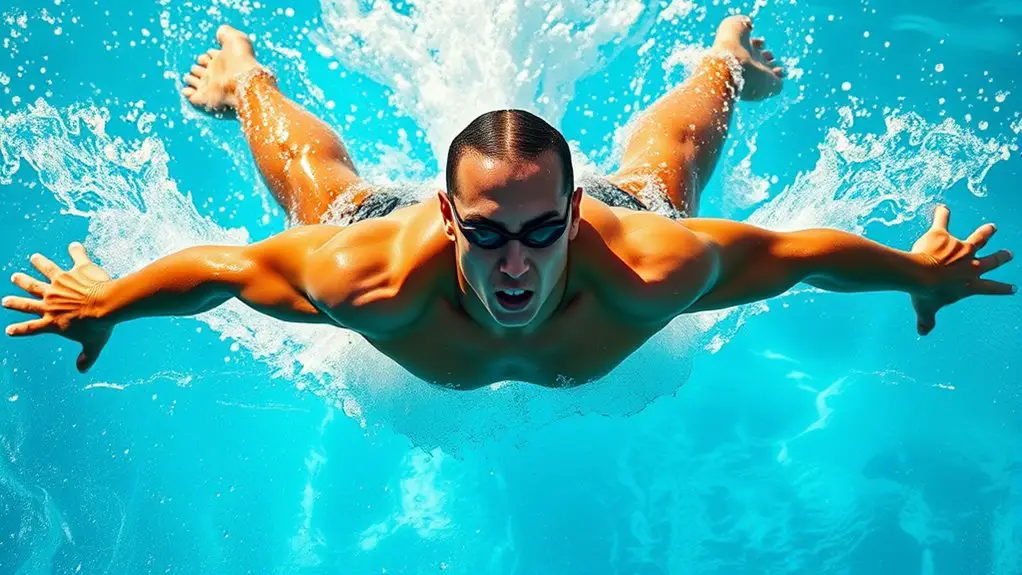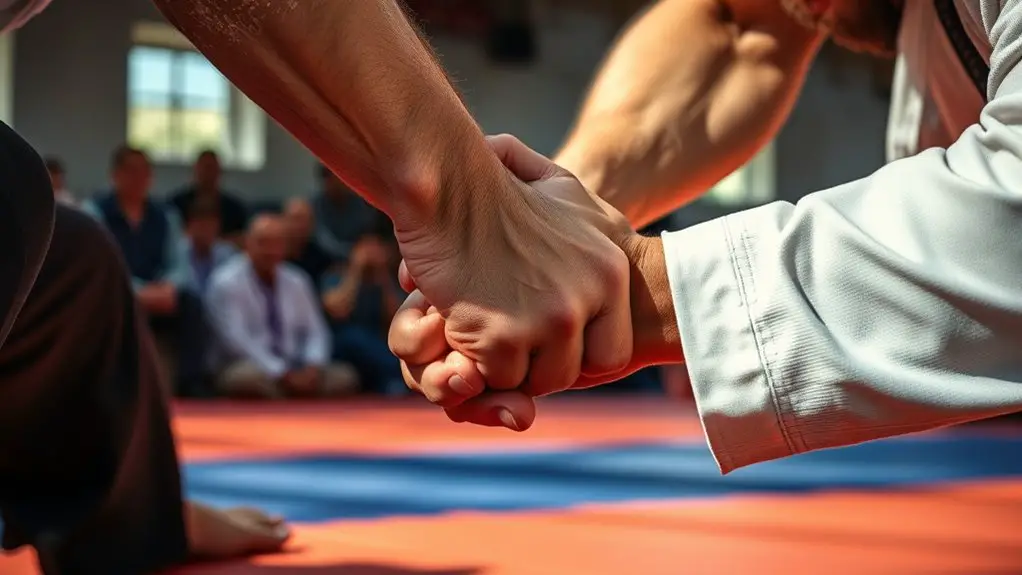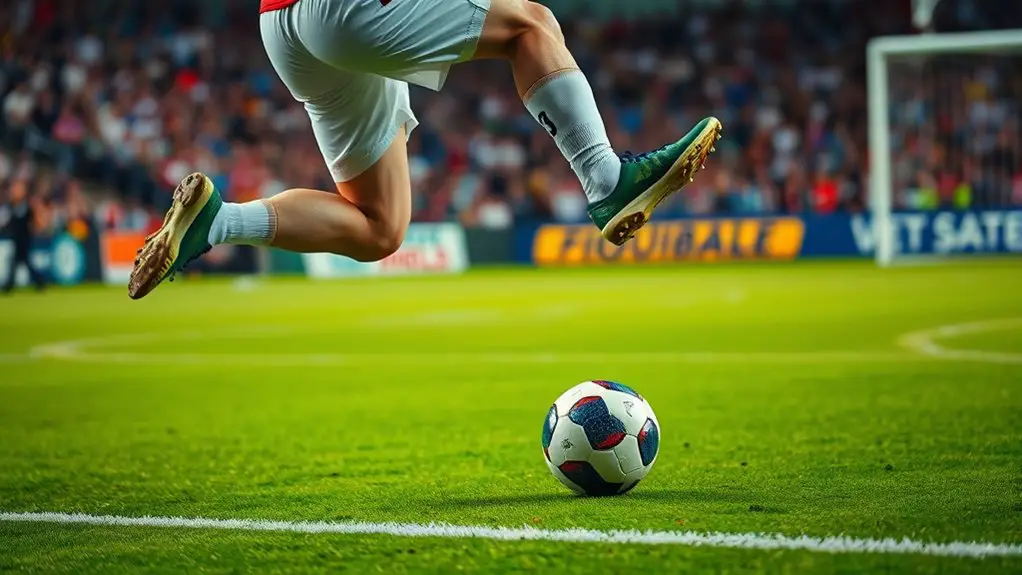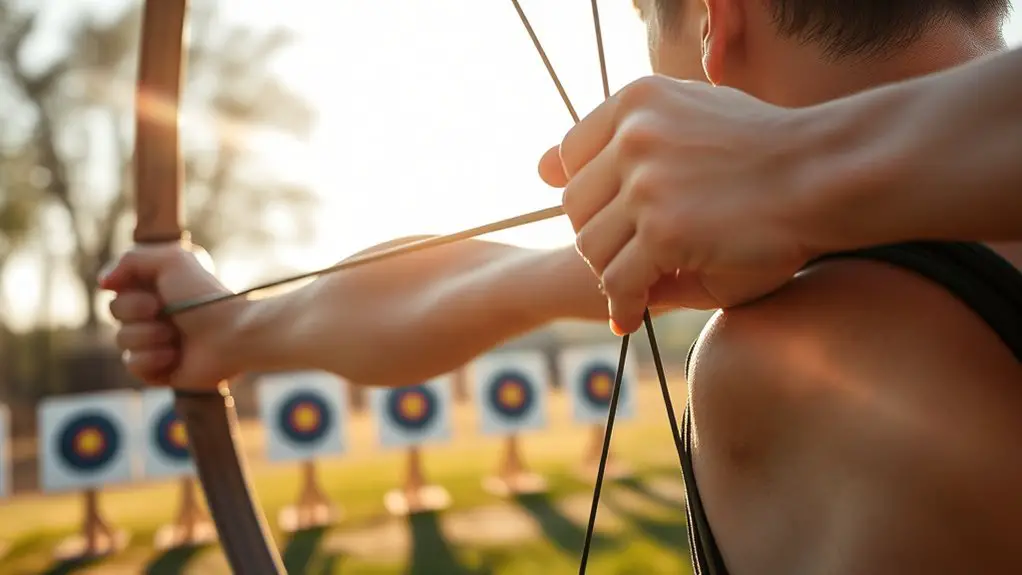To master the biomechanics of an efficient butterfly stroke, focus on body position and alignment, keeping your torso flat and hips low to reduce drag. Your arm movement should be precise, with high elbows during the pull and relaxed recovery. Practice undulation from your chest, ensuring your hips drive the motion. Timing your breath with the pull phase is essential for maintaining rhythm. By refining these elements, you'll enhance your performance and efficiency in the water—discover more as you explore further.
Understanding Body Position and Alignment
When you plunge into the butterfly stroke, understanding body position and alignment is essential for maximizing efficiency and speed. You've got to find that sweet spot where your body alignment is just right. Keep your torso flat and your hips positioned low in the water; this reduces drag and makes you glide effortlessly. Picture your body as a streamlined arrow, cutting through the waves.
Your hips should drive the rhythm of your stroke, allowing for a fluid undulation. If your hip positioning is off, it can throw everything out of balance, making each stroke more exhausting than it needs to be. Focus on keeping your core engaged, which will help maintain proper alignment throughout your movements. A strong core will also enhance your overall stability in the water. By mastering these elements, you'll not only swim faster but also feel a liberating sense of flow, allowing you to enjoy the freedom of the water like never before.
The Role of Arm Movement in the Butterfly Stroke
Although mastering body position is essential, the role of arm movement in the butterfly stroke is equally important for achieving ideal performance. Your arm mechanics directly influence stroke power, allowing you to glide effortlessly through the water. When you pull and push with precision, you create a rhythm that enhances your overall speed.
Here's a quick reference table to help you understand the key aspects of arm movement:
| Aspect | Description | Impact on Performance |
|---|---|---|
| Entry Position | Arms enter the water shoulder-width apart | Maximizes pull efficiency |
| Pull Phase | Elbow high, hands sweep back | Increases stroke power |
| Recovery Phase | Arms extend forward, relaxed | Reduces drag |
Mastering the Undulation Technique
To achieve an effective butterfly stroke, mastering the undulation technique is essential because it creates the necessary rhythm and propulsion through the water. This technique relies on undulation mechanics, where your body moves in a wave-like motion. When you engage your core and initiate the movement from your chest, you'll feel the fluidity of your body generating power.
As you undulate, let your hips drive the motion, allowing your legs to follow in a smooth, synchronized wave. This not only enhances your speed but also maintains energy efficiency, giving you the freedom to glide through the water with ease.
Practice this wave motion regularly, and focus on feeling the rhythm in your body. The more natural the motion feels, the more powerful your stroke becomes. Embrace the sensation of flowing through the water, and you'll find yourself mastering the undulation technique in no time.
Timing and Coordination of Breath
When you're mastering the butterfly stroke, timing your breath is essential. You need to coordinate your breathing with each stroke to maintain rhythm and efficiency. This balance not only helps you stay streamlined but also maximizes your power in the water.
Timing of Breath
Proper timing of breath is essential in the butterfly stroke, as it directly influences your overall efficiency and speed. Mastering breath control is vital, and using effective timing techniques can make all the difference. Here are three key tips to enhance your breath timing:
- Breathe During the Pull: Inhale as your arms enter the water, allowing for a smooth shift.
- Limit Head Movement: Keep your head low to maintain body position and reduce drag.
- Exhale Underwater: Release air as you're completing your stroke, so you're ready to inhale when you surface.
Coordination With Stroke
While mastering the butterfly stroke, coordinating your breath with your arm movements is essential for maximizing efficiency and speed. Your body awareness plays a vital role in aligning your breath with the stroke rhythm. Timing your breath during the pull phase allows you to maintain momentum, reducing drag and enhancing your glide through the water.
| Breath Timing | Effect on Stroke |
|---|---|
| Early | Increases drag |
| Late | Disrupts rhythm |
| Perfect | Maximizes flow |
| Consistent | Builds endurance |
| In sync | Enhances speed |
When you find that sweet spot, you'll feel a liberating connection between your breath and movements, allowing you to soar effortlessly through the water. Embrace this freedom to elevate your performance!
Energy Expenditure and Efficiency
When you focus on ideal body position and stroke timing, you can greatly improve your energy efficiency in the butterfly stroke. Fine-tuning these elements not only reduces fatigue but also enhances your overall performance. Understanding how to coordinate your movements will help you swim faster while expending less energy.
Optimal Body Position
To maximize energy efficiency in the butterfly stroke, maintaining an ideal body position is essential. You'll want to focus on achieving proper body alignment and core stability for peak performance. Here are three key aspects to take into account:
- Straight Line: Keep your body in a straight line from fingertips to toes, minimizing drag.
- Hip Position: Make sure your hips are high in the water, allowing for smoother movements and less resistance.
- Core Engagement: Activate your core muscles to maintain stability and control, helping you glide effortlessly through each stroke.
Stroke Timing Coordination
Effective stroke timing coordination is essential for minimizing energy expenditure and maximizing efficiency in the butterfly stroke. You need to establish a smooth stroke rhythm, which hinges on your motor control. By synchronizing your arm movements, kicks, and breathing, you create a seamless flow that reduces drag and conserves energy.
| Component | Timing | Effect on Performance |
|---|---|---|
| Arm Stroke | Initiate as feet kick down | Enhances propulsion |
| Dolphin Kick | Follow arm entry | Maintains body position |
| Breathing | Time with arm recovery | Prevents disruption |
| Stroke Cycle | Maintain consistent rhythm | Increases efficiency |
Mastering stroke timing coordination allows you to swim with freedom and grace, making each lap feel effortless.
Common Mistakes to Avoid
Though mastering the butterfly stroke can be challenging, avoiding common mistakes can greatly enhance your performance. By steering clear of these technique pitfalls, you'll swim more efficiently and feel more liberated in the water.
- Overexerting Your Arms: Many swimmers make the common error of pulling too hard with their arms. This can lead to fatigue and disrupt your rhythm. Focus on a relaxed and fluid motion instead.
- Improper Body Position: If your body sinks too low in the water, it creates unnecessary drag. Keep your hips high and maintain a streamlined position to glide effortlessly.
- Ineffective Kicking: A weak or inconsistent kick can throw off your entire stroke. Verify you're using a strong, rhythmic dolphin kick to propel yourself forward. Staying hydrated during training can also support optimal performance, helping you maintain the energy needed for effective kicking.
Drills and Practices for Improvement
Improving your butterfly stroke involves more than just avoiding mistakes; it requires focused practice and targeted drills. To elevate your technique, explore various drill variations. Start with one-arm butterfly drills to isolate your arm movements while keeping your body aligned. You can also incorporate vertical kicking drills to enhance your kick strength and timing.
Mix up your practice routines to keep things fresh and engaging. Alternate between shorter, high-intensity sets and longer, endurance-focused swims. Consider using fins or a pull buoy to develop specific muscle groups without straining others. Additionally, incorporating mobility training into your routine can enhance your range of motion, facilitating more efficient movements in the water.
Don't forget to include video analysis or feedback from a coach to spot areas for improvement. Remember, the key is consistency; dedicate time each week to these drills and practice routines, and you'll see your butterfly stroke transform into a more efficient and powerful movement. Embrace the journey, and enjoy the freedom of gliding through the water!
Frequently Asked Questions
How Does Flexibility Impact the Butterfly Stroke Performance?
You might think flexibility isn't that important in swimming, but it actually plays a vital role in your butterfly stroke performance. Improved flexibility benefits you by enhancing your range of motion, allowing for a more fluid and powerful movement. With greater range enhancement, you can glide through the water more efficiently. Embracing flexibility not only helps you swim better but also gives you the freedom to explore your full potential in the pool.
What Are the Best Stretches for Butterfly Swimmers?
For butterfly swimmers, incorporating both dynamic and static stretches is key to enhancing your performance. Start with dynamic stretches like arm circles and leg swings to warm up your muscles. After your swim, focus on static stretches, such as the butterfly stretch and chest openers, to improve flexibility and recovery. These routines will keep you feeling free and fluid in the water, helping you glide effortlessly through each stroke.
How Can Mental Focus Improve My Butterfly Technique?
Imagine a painter, meticulously envisioning their masterpiece before a single stroke. Just like that artist, you can enhance your butterfly technique through mental focus. Utilizing visualization techniques allows you to mentally rehearse your strokes, while mindfulness practices help you stay present during practice. By centering your thoughts, you'll find a flow that frees your movements, leading to a more fluid and efficient swim. Trust your mind, and watch your performance soar!
What Is the Ideal Training Frequency for Mastering Butterfly?
To master the butterfly, you'll want to find a training schedule that suits your lifestyle. A good frequency is about three to five sessions a week, allowing for variations based on your progress and energy levels. Mixing in technique drills, endurance work, and even some fun, free swim sessions keeps things fresh. Remember, it's all about enjoying the process while building those skills, so listen to your body and adjust as needed!
How Does Nutrition Affect Butterfly Stroke Efficiency?
Imagine powering through your butterfly stroke with effortless grace, only to feel drained moments later. That's where nutrition timing and energy balance come in. You've got to fuel your body right before and after training to enhance your performance. Eating the right carbs and proteins at the right times can help you maintain energy levels and recover faster, giving you the freedom to glide through those challenging laps with ease and confidence.




